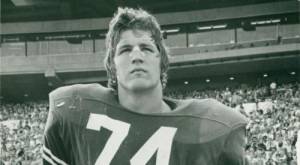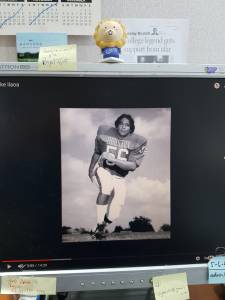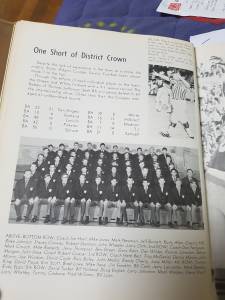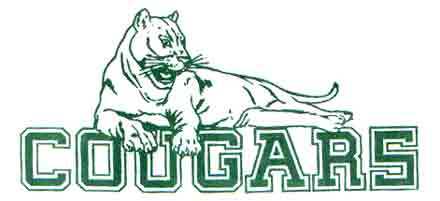Football is big in Texas, I know. Probably too big, but what can we do? Since early in the 20th century, it has been integral to the state’s culture. Please permit me to wax nostalgic by thinking back to the team that represented my alma mater—Bryan Adams High School in Dallas—on the gridiron almost 47 years ago.
Bob Cowsar, head coach since the school opened in 1957, was in his penultimate season. (In 1972, he would be “kicked upstairs” in the Dallas Independent School District administration.) Who knew that the crusty Cowsar had played minor league baseball in the 1940s? Yes, indeed—he pitched for such teams as the Lamesa Lobos, Topeka Owls, Sweetwater Sports, Ballinger Cats and Odessa Oilers.
Fine athletes on Cowsar’s ’70 team
Cowsar and his assistants, Jimmy Don Hunt (his successor in ’72), Herb Best and Don Ferguson, had selected and drilled a team with a lot of potential. Let’s start with the studliest players: Tommy King and Blake Johnson. These two young men played their junior high ball at Hill. Both had made the varsity in 1968 and immediately won starting jobs although that senior-dominated team went 12-1 and had 10 players who got college scholarships. King, a linebacker, was 190 pounds of pure muscle. Johnson, originally a defensive back, soon shifted to running back and kick returner. Blessed with size, speed and moves, he was a tremendous player. Both King and Johnson would start 30 games for the green and  white in the 1968, 1969 and 1970 seasons. That’s some impressive stuff. Of course, I do not mean to take anything away from a certain ex-Gaston Warrior. I refer to Mr. Doug English, a defensive lineman destined for greatness with the Texas Longhorns and Detroit Lions.
white in the 1968, 1969 and 1970 seasons. That’s some impressive stuff. Of course, I do not mean to take anything away from a certain ex-Gaston Warrior. I refer to Mr. Doug English, a defensive lineman destined for greatness with the Texas Longhorns and Detroit Lions.
The quarterback position was won by Mark Beesley, who had labored away from the spotlight on the junior varsity the previous two years. One other player, besides King and Johnson, had made the varsity as a soph—Steve Richey, a tall QB. The coaches may have thought he would learn under Randy Cavender in ’68 and then start for two seasons. But it did not turn out that way; Richey failed to win the job over an ex-JV guy named Randy Rutledge in ’69 (when the Cougars went a miserable 4-6), nor could he beat out Beesley. Richey, who was given every opportunity to be the man, never started a single game. In fact, he was not even the second-string quarterback in 1970. That was the left-handed Quency Hill, who played quite a bit although Beesley took most of the snaps.
We had some tough-as-nails defensive backs, like Jim Franklin, Rusty Allen, Stacey Conway and Dennis Moore. Ricky Epps, who I believe doubled as a DB and wide receiver, was probably Bryan Adams’ fastest player—not to take anything away from Ben Green, a burner himself. Mark Crouch was a superb athlete and all-around football player. Ronny Johnston, a substitute running back, made solid contributions as the season went on. The 1970 Cougars had a slew of excellent linemen, apart from English: Mike “Herbie” Illao, Mark Walden, Bill Cash, Fred Williams, David Coyle, Larry Johnston and Steve Stuart. Troy McDaniel and John Illao played tight end, if I remember correctly. The underrated Joe Windsor spent  time in the backfield and as a linebacker alongside King. Joe York, a rough-and-ready fellow if ever there was one, suffered a leg injury during the 1969 season and did not play as a senior. Larry Whatley, a blond-headed junior, handled all kicking duties; he had a powerful right leg.
time in the backfield and as a linebacker alongside King. Joe York, a rough-and-ready fellow if ever there was one, suffered a leg injury during the 1969 season and did not play as a senior. Larry Whatley, a blond-headed junior, handled all kicking duties; he had a powerful right leg.
A sparkling season for the green and white
The Cougars, playing in District 11-AAAA, proved their mettle in the first game of the season, a 22-21 comeback victory over San Angelo. They squeaked by Garland and then trounced Lincoln, Pinkston, Spruce and W.T. White. In the latter game, Johnson scored one TD and ran for 157 yards on 13 carries. Defeats of Hillcrest and Madison were close. Then came a heartbreaking 14-11 loss to Thomas Jefferson. Cowsar opened himself up to some criticism for not running Johnson enough in that defeat by the Rebels. In fact, sometimes No. 22 was standing on the sidelines waiting to go back in. We didn’t, but we should have hollered from the stands: “Hey, Coach, you want to win this game? Johnson’s our best running back. Get him in there! And put the ball in his hands. It’s not that heavy.” The season ended with a 21-0 skunking of Samuell.
The 1970 Bryan Adams team went 9-1 (with four shutouts) and did not reach the playoffs, which is a pity. In the intervening years, the University Interscholastic League and Texas High School Coaches Association have changed the system drastically, which is to say it’s now far easier to get in the playoffs than in the olden days. We lost one district game, TJ lost none, and we were out—simple as that. It could have been different. What if Cowsar had ridden the splendid Johnson to victory over the Rebs that night at Loos Stadium? We would have entered the playoffs with an undefeated record. I dare say we might  have won the city championship and another playoff game or two. Is it possible that BA would have gone on to capture the 4A state title (won by Reagan High School of Austin)? Yes, it is, especially if we had been more creative by mixing in halfback passes, reverses, fake punts and onside kicks to keep our opponents on their toes. Cowsar was not modern-minded enough to do those things, but they would have increased our chances of winning tough playoff games.
have won the city championship and another playoff game or two. Is it possible that BA would have gone on to capture the 4A state title (won by Reagan High School of Austin)? Yes, it is, especially if we had been more creative by mixing in halfback passes, reverses, fake punts and onside kicks to keep our opponents on their toes. Cowsar was not modern-minded enough to do those things, but they would have increased our chances of winning tough playoff games.
Excellent cardiovascular shape
I was quite proud of the 1970 Cougars who acquitted themselves well. Just making the team was hard—I can tell you because I tried out in the summer before my sophomore year and got cut—and they used to do some serious head-knocking out on the practice field. The slightest infraction could spur Cowsar et al. to line up the entire squad and make them run a series of sprints from goalpost to goalpost. Whether this constituted sadism, punishment, a motivational ploy or some mixture of all three, the players hated it. Nevertheless, they were in good condition throughout the season.
BA football went into a long-term decline soon after we left. The Cougars did win a district title under Hunt in 1977 and squeaked into the watered-down playoffs in 1985, 2006 and 2008, but otherwise they were and continue to be also-rans.


4 Comments
The way I remember it: WT White and Bryan Adams both had 9-1 records. BA beat WT White, WT White beat TJ, and TJ beat Bryan Adams. Because WT White beat TJ and we didnt, WT White won the district that year.
I did not mean to slight the WT White Longhorns, just didn’t know they did so well. I knew BA beat them. If what you say is correct, all three teams finished with 9-1 records. Thanks for commenting, John.
I do know that Fall of 1971, both WTWhite and TJ were undefeated going into the Homecoming Game. We sold out Loos Stadium and got to play in the Cotton Bowl. WTW won!!!
Fall of 1971? By that time, I was a freshman at the University of Texas. My focus was the Longhorns–and I am not talking about the WT White Longhorns. I had left high school behind. So whoever won some game at Loos Field is irrelevant to me. Sorry.
Add Comment